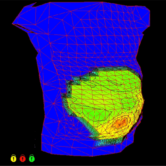Research Highlights
ARKANSAS: Clinical study suggests measuring uterine muscle activity could inform strategies for safer and faster childbirth (feat. UAMS)
Artificially causing – or inducing – labor is becoming increasingly common, yet this practice comes with risks and its level of success is difficult to foresee. But now, new research may offer a way to help predict outcomes and improve the process.
Researchers at the University of Arkansas for Medical Sciences (UAMS) have devised a non-invasive method of accurately measuring the electrical activity of uterine muscles. The results of a recent clinical study, published in the journal Current Research in Physiology, show that signals measured in pregnant patients prior to induction are strongly tied to whether their labor lasted less or more than 24 hours. The authors indicate that physicians could use the method to learn how patients might respond to induction and use the information to develop more effective strategies for labor and delivery.
ALASKA: New NSF-supported research explains "Atlantification" of the Arctic Ocean
New research by an international team of scientists describes the causes for the stalled trend in Arctic Ocean sea-ice loss since 2007. Environmental responses to the Arctic dipole are described in a paper published in the journal Science. The analysis helps explain how North Atlantic water influences the Arctic Ocean climate. Scientists refer to this phenomenon as Atlantification.
The NSF-supported research is led by Igor Polyakov of the University of Alaska Fairbanks.
ALABAMA: NSF-supported researchers delve into the fusion of computational modeling and experimental biophysics (feat. Auburn University)
In a paper in Biophysical Journal, biophysicist Rafael Bernardi of Auburn University and his colleagues shed light on the capabilities of the next generation of supercomputers in reshaping the landscape of biophysics.
The NSF-supported researchers delve into the fusion of computational modeling and experimental biophysics, providing a perspective for a future in which discoveries are made with new precision.
KENTUCKY: NIH-funded research finds telehealth supports retention in treatment for opioid use disorder
Starting buprenorphine treatment for opioid use disorder through telehealth was associated with an increased likelihood of staying in treatment longer compared to starting treatment in a non-telehealth setting, according to a new study analyzing Medicaid data from 2019-2020 in Kentucky and Ohio. Published in JAMA Network Open, these findings add to a growing body of evidence demonstrating positive outcomes associated with the use of telemedicine for treatment of opioid use disorder.
The research was conducted as part of the HEALing Communities Study, the largest addiction prevention and treatment implementation study ever conducted, which is supported by the National Institute on Drug Abuse (NIDA) and carried out in partnership with the Substance Abuse and Mental Health Services Administration (SAMHSA) through the National Institutes of Health’s Helping to End Addiction Long-term Initiative, or NIH HEAL Initiative.
IOWA: Scientists Ratchet Up Key Amino Acid in Corn with USDA NIFA-funded Research
Experimental lines of field corn developed by a team of Agricultural Research Service (ARS) and university scientists will usher in new commercial hybrids offering high-methionine grain. The advance, reported in a recent issue of Crop Science, will be especially welcome news for organic poultry producers whose birds require dietary formulations of the amino acid to ensure optimal growth, health and production of meat and eggs.
ARS plant geneticist Paul Scott co-authored the Crop Science paper describing the advance together with other researchers including Shelley Kinney, Thomas Lübberstedt and Ursula Frei (all of Iowa State University in Ames). Project was conducted with support from USDA NIFA.
SOUTH CAROLINA: High school student doing research at Coastal Carolina University has discovered a microorganism
A high school student doing research at Coastal Carolina University has discovered a microorganism with antibiotic properties against E. coli bacteria. Writes the lab PI, Dr. Paul Richardson, “We found the organism last week, but this test proves it wasn’t chemical in nature. Now we have to isolate and identify the microorganism. This discovery was made possible through the South Carolina INBRE program.”
ALABAMA publishes trial about myopia in JAMA Ophthalmology
Use of low-dose atropine eyedrops was no better than placebo at slowing myopia (nearsightedness) progression and elongation of the eye among children treated for two years, according to a randomized controlled trial conducted by the Pediatric Eye Disease Investigator Group and funded by the NIH National Eye Institute. Results were published in JAMA Ophthalmology.
“It's possible that a different concentration of atropine is needed for US children to experience a benefit,” noted the study’s lead co-author, Katherine K. Weise, University of Alabama at Birmingham. “Clinical researchers could evaluate new pharmaceuticals and special wavelengths of light in combination with optical strategies, like special glasses or contact lenses, to see what works in reducing the progression of myopia.”
KENTUCKY: KY FIRST ROBOTICS – BREAKING BARRIERS IN STEM EDUCATION
Kentucky NSF EPSCoR is proud to partner with KY FIRST® Robotics to help fund and support instructional curriculum for their First Tech Challenge program, for grades 7-12. KY FIRST Robotics is a “progression of robotics competitions for kids, beginning with the youngest innovators and going through high school… FIRST encourages it participants to think outside the box.”
KANSAS: NSF MAPS project reaches 16 middle school science teachers
16 middle school science teachers will visit the University of Kansas Field Station to explore resources and gain new ideas to take into their classrooms. The teachers serve in school districts representing a diversity of students, both urban and rural. The Summer Institute is part of an NSF EPSCoR project funded through a $20 million grant announced in 2017. The NSF project, “Microbiomes of Aquatic, Plant, and Soil Systems across Kansas (MAPS),” RII Track-1 Award, is a collaboration among five Kansas universities. Matching support comes from the state of Kansas through the Kansas Board of Regents.









